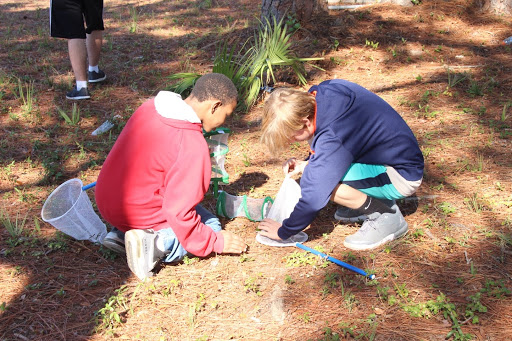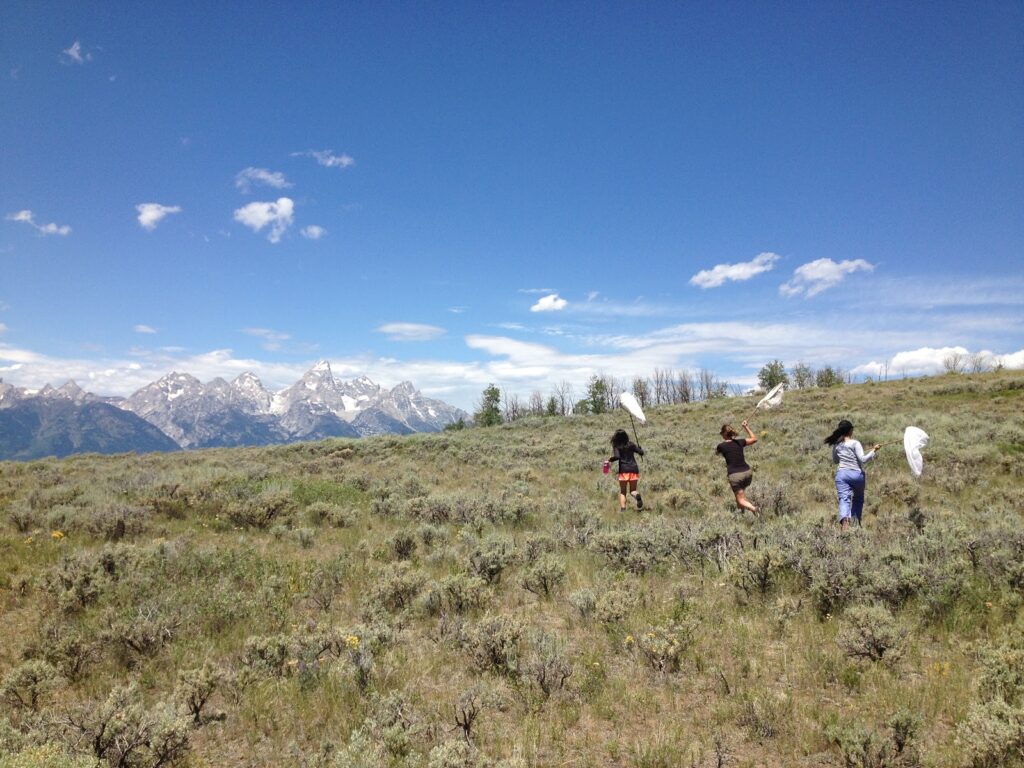Teton Science Schools has long understood the value, impact and fun that comes along with participating in citizen and community science (CCS) — or in short, public participation in scientific research. We do it with visiting school and teacher groups through programs like Nest Watch and Wyoming Stream Team, we do it with our youngest Mountain Academy students and we do it with our oldest students as part of the Graduate Program.
Next week — in celebration of the TSS Graduate Program’s Class of 2020 — we’re throwing our first ever “socially-distanced” community bioblitz, a CCS event designed to get our community outside in their neighborhoods, backyards or even just looking out their windows, to share local biodiversity and contribute to global biodiversity knowledge. As we prepare, we thought it only made sense to connect with graduate program alumna (and current bioblitz committee member), Amy Lorenz, to share her story in citizen and community science, why she’s so passionate about it and how bringing communities together through science is really the most exciting part of it all.
Let’s dive in.
Ok. First things first, we’re so excited for this event. Can you tell our readers what citizen science is and what inspired doing it as a way to celebrate the current graduate program cohort?
In short, citizen science is public participation in scientific research and includes a wide variety of activities like crowdsourcing, volunteer-trained field research and local, community-driven environmental monitoring. And it benefits everyone. It allows researchers to gather large amounts of data over a wide geographic range, educates participants about their environment and empowers citizens to use the scientific process to address local issues.
The last few months of the graduate program have been somewhat untraditional in the wake of our global pandemic — some students remain here at the Kelly Campus and others have traveled home for the remainder of the program while they all engage in distance learning. Aaron Nydam, Director of the Graduate Program, suggested a community bioblitz as a way to wrap up our current cohort’s experience by documenting natural history in everyone’s local place. It’s also a way to bring our community of graduate program alumni together to celebrate the signs of spring for a shared experience in a time when people feel spread out geographically and socially.
Can you tell our readers what a bioblitz is?
Bioblitz: Bio=life, blitz=really fast! A Bioblitz is an effort to record as many species in a particular area in a short time. They can be casual or use specific methodologies, and range from a few hours to several days to seasonal/annual monitoring events. They bring together experts, enthusiasts, and amateur naturalists and are really really fun ways to “discover” biodiversity anywhere!
So, how can folks get involved next week?
Getting involved is easy! You don’t need to be a grad student or alum–everyone is welcome. We will be using iNaturalist.org, a CSS platform where users contribute to global biodiversity knowledge. Our observations will be collected in a project that will update observations on a map real-time. Once others in the iNaturalist community verify an observation, it becomes “research grade” and flows into several global biodiversity databases for researchers to access.
All you have to do is RSVP here and we’ll send out more details on how to get set up!

Awesome! So, back to you. How did you first connect with us here at Teton Science Schools?
I grew up outside Philadelphia and was always interested in natural history and biology. When I was 12, I attended Middle School Field Ecology at Teton Science Schools and remember hiking around the Kelly Campus, learning about trees at the rock garden and going on our backpacking trip in the Gros Ventres.
After college, I was eager to spend a year teaching in outdoor education while I figured out my path, and soon after I started I knew it was a career I wanted to pursue. I spent a few years teaching in California during the school year and teaching about whales on the east coast during the summers. Around that time, I started looking at master’s programs and stumbled upon the TSS website and the grad program — it looked like a great match for my interests and learning style and I ended up enrolling in the Fall of 2012.
Now I currently work with the Teacher Learning Center and Place Network, splitting my time between Jackson and directing a marine science summer program on the east coast!
How did you first get involved with CSS?
I think my first formal introduction to CCS was in the grad program when we participated in the Wyoming Stream Team and even did a bioblitz in Yellowstone as part of our coursework. When I went to the University of Wyoming to continue my Master’s, I had the opportunity to work with Dr. Ana Houseal on an extension of her research with student-teacher-scientist partnerships and a citizen science project with students in Yellowstone. My master’s project was focused on the influence of a citizen science project in Yellowstone on local students’ understanding of science practices, attitudes, and sense of place.
That’s super cool. So, where has your citizen science journey taken you since your grad school days?
After grad school, I was excited to look for an opportunity in the citizen science field. I moved to Boston to join the  Encyclopedia of Life (EOL) project at the Harvard Museum of Comparative Zoology. EOL is a website that gathers and shares trusted information about every species on earth. I joined the education team, and was primarily working on a place-based grant to increase localized knowledge and connection to place for students in a military community in Florida through community science.
Encyclopedia of Life (EOL) project at the Harvard Museum of Comparative Zoology. EOL is a website that gathers and shares trusted information about every species on earth. I joined the education team, and was primarily working on a place-based grant to increase localized knowledge and connection to place for students in a military community in Florida through community science.
I developed local biodiversity curriculum, led professional development programs, and organized school and community bioblitzes with local researchers and naturalists. Students loved chasing butterflies, finding lizards, sorting critters by characteristics and feeling like “scientists” with local experts. We also worked locally with schools around Boston and organized the City Nature Challenge, an annual four-day global bioblitz. iNaturalist quickly became my favorite app and website, to document what I was finding and learn about the amazing biodiversity right under my feet.
Funny enough, when I was at EOL I collaborated on a project with Jo Snyder, who was one of the grad students who led my backcountry trip when I came to TSS in middle school!
Small world! We can tell you’re passionate about CCS. What excites you most about it?
I am super excited about creating opportunities for students to get involved and the potential learning outcomes. Participating in CCS directly engages students in the scientific process, increasing their understanding of science practices and building deep knowledge of the topic that they are studying. Beyond content knowledge, research indicates that CCS breaks down barriers between the public and scientists, and promotes student agency through authentic, meaningful contributions beyond the classroom walls.
What’s currently happening in the world of citizen science right now?
The field of citizen science is changing in many exciting ways. While the primary objective in early citizen science projects was to gather large amounts of data for scientists, now projects are increasingly focused on the volunteer experience (volunteers who feel empowered about their contributions continue involvement), educational outcomes (the more participants learn, the more motivated they feel), and engaging a wider audience (shifting from primarily retired, well-educated volunteers to students, educators, families, environmental justice groups, community members in rural to urban areas).
The identity of citizen science is also shifting to community science or “citizen and community science (CCS)” — to de-emphasize the idea that to participate one must be a “citizen” and emphasize the community. It also addresses the spectrum of projects that are global or remote and those that are community-based efforts. This is a really important reflection on how the field has recognized the power of community science in our society.
 Those sound like some really important shifts! How does it all align with the work we do as place-based educators?
Those sound like some really important shifts! How does it all align with the work we do as place-based educators?
CCS fits right into our place-based education framework, particularly in local-to-global context, community as classroom, and inquiry. The wide variety of citizen science projects allows students to engage in long-standing global projects with specific protocols (structured inquiry) and to collaborate with a local scientist in designing their own project and methods born from questions they ask about their own community (open inquiry). Some examples include projects that address water and air quality, invasive species, and public health concerns.
What excites you most about the impact the bioblitz could have?
I’m excited for our community to gather together in a different way, and the potential for bioblitzes and other community science projects to connect TSS across departments, campuses and the Place Network. We hope that these events can grow into a student inquiry-driven effort to document and share biodiversity data across all of our networks!
Thanks, Amy! You’re a wealth of knowledge when it comes to community and citizen science and we can’t wait to join you and the greater TSS community at the BioBlitz next week!


